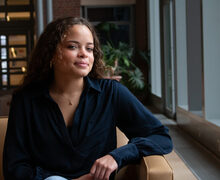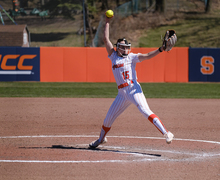Riley Figueiras’ club, high school play prepared him for return from ACL tear
Meghan Hendricks | Senior Staff Photographer
Riley Figueiras missed his entire freshman season due to a torn ACL, but the long pole has become a consistent starter on Syracuse's defense in 2024.
Get the latest Syracuse news delivered right to your inbox. Subscribe to our sports newsletter here.
Ask Riley Figueiras about his right ACL tear and he’ll first mention the date: October 14, 2022. The play he made that day was routine — a simple dash for the ball which just popped out of someone’s stick. The result was anything but normal. An awkward plant of his right leg resulted in the complete disappearance of his right knee.
“Your ACL is not there,” Figueiras said. “You don’t know what it’s going to take to get back. But you know how difficult it is just from hearing other people.”
Figueiras’ nine-month recovery journey was still different. Despite being a freshman, junior Saam Olexo wanted to learn from Figueiras after taking over his close defender position last season. Olexo knew Figueiras had years of experience guarding top national players at the club and high school level.
In one particular game, Duke’s Andrew McAdorey beat Olexo early. Figueiras told Olexo what he would do against McAdorey. Olexo wasn’t scored on the rest of the game.
Now fully recovered from his ACL tear, Figueiras plays alongside Olexo instead of giving tips from the sidelines. Wearing No. 11, given to the best player on Syracuse’s defense, he has quickly stood out in John Odierna’s unit. He’s shown no sign of slowing down since high school, when he won 65 straight club games with the Annapolis Hawks and wasn’t scored on his entire senior year at St. John’s College High School.
“Being able to play at a top high school and a top club team, you know you can play against these top guys,” Figueiras said. “Definitely being at the top then, it gives you the confidence to do it again.”

Cole Ross | Digital Design Editor
Figueiras began playing for the Hawks in fifth grade, staying with them through high school. Hawks coach Tom Ripley put a premium on footwork, comparing defense in lacrosse to basketball where it’s “feet first.”
Before every game, Ripley had his defenders do a simple box drill. Run up, shuffle to the side, backpedal and repeat.
“That’s not an accident, it’s the most important,” Ripley said about pregame drills. “The stick is secondary. It’s important, but in youth lacrosse it’s infinitely less important.”
Figueiras continued working on his footwork at home alongside Ryan, his older brother who was an attack at Detroit Mercy from 2018-22. The duo placed a ladder on the soft carpet of their basement, alternating running through it as basketball or football played on the TV in front of them.
When Figueiras was in middle school, they taped the two televised college lacrosse games from the weekend every week, including matchups between Maryland and Syracuse. While Ryan focused on the attacks, Figueiras looked at Nick Mellen and Brett Kennedy as he cycled through the ladder.
The brothers took their skills from the basement to outside, battling one-on-one since Figueiras picked up a stick to when Ryan left for college. They fought against each other on a hill in their backyard or at The Calverton School nearby.
Figueiras said he gained a lot of confidence going against his brother, adding some moves to his repertoire as well. In seventh grade, Figueiras mastered the wrap check, wrapping his stick around opponents’ bodies to take the ball away. He immediately brought it to the Hawks’ practice.
“He rolls this thing out, it is just really really nasty,” Ripley said. “He just got a knack for it. He got really good at setting it up and timing it properly.”
Heading into eighth grade, Figueiras made another big change with the Hawks. Because of injuries, Ripley moved Figueiras from close defender to long-stick midfielder for the summer. Ryan said it helped him master the spacing on the field, making him a better one-on-one player before he switched back to close.

Riley Figueiras (pictured, No. 11) weaves through Colgate’s offense to track the ball in Syracuse’s win over the Raiders on Feb. 5. Joe Zhao | Asst. Photo Editor
One-on-one play is the bread and butter of club contests, Figueiras said, since players are trying to impress college coaches to get recruited. So before each game, Figueiras focused on knowing the dominant hands of his opposition and what dodges to expect. He never concentrated on throwing checks, instead dominating matchups with Joey Spallina at the Lake Placid Summit Classic with his feet. (One year, he held Spallina to just one assist.)
“Defense isn’t flashiness with split dodges or roll doges and all that,” Figueiras said. “It’s kind of just doing what everyone does and doing it at a higher level.”
In high school, as attacks slowly stopped relying on solo play, Ripley said Figueiras started “enhancing his teammates.” Syracuse defender Billy Dwan, who joined the Hawks as a sophomore, said Figueiras’ strength was his communication.
“He always communicates, which is an underrated skill on defense,” Dwan said. “If you’re not communicating you’re probably doing the wrong thing.”
Figueiras understood the importance of communication playing in front of goalie George Alvarez as a freshman at St. John’s. Alvarez, now a junior at Harvard, was a “non-stop talker,” telling everyone on defense what to do.
“You’re not just saying what you’re doing, you’re helping your teammates out,” Figueiras said.
That type of communication was necessary at St. John’s because of the elite competition it faced in the Washington Catholic Athletic Conference. Opposing attacks ran complicated sets which required more rotations and higher-level thinking, Figueiras said. To learn how to stop them, head coach Wes Speaks taught Figueiras the importance of analyzing film.
Speaks helped Figueiras look for how other teams got the ball to their best players. Instead of watching professional or collegiate play in the basement, he examined clips of his opposition on Hudl at home in the two or three days between each game. If he had questions, he asked Ryan why an attack made the decision they did.
With a deeper understanding of preparation, Figueiras dominated the conference as a senior. He said good attacks tested him at the beginning of games, throwing five or so dodges before giving up. The Cadets went 19-0 that year, only giving up double-digit goals twice as Inside Lacrosse’s No. 1 high school in the country.
“That was the culmination of all the years of putting that work together,” Figueiras said.

Riley Figueiras (pictured, No. 11) adjusts to stop a Hobart attack during an SU win on March 23. Meghan Hendricks | Senior Staff Photographer
Figueiras’ historic final season at St. John’s was vastly different from the start of high school. Ryan said the transition for Figueiras was tough since he’d never played against many older players before on the club circuit.
Rather than going against Ryan, Figueiras further improved his one-on-one play versus then-junior and current Georgetown attack TJ Haley after practice. Ten games into the year, he was slated against St. Paul VI Catholic High School’s then-senior Jacob Angelus, whose talent was far above most players he had ever faced. Figueiras won the matchup.
“That was a big moment for me because he was the big recruit, one of the best players in the conference,” Figueiras said.
This year, Figueiras guarded Angelus again when Syracuse played then-No. 2 Johns Hopkins. Though a sophomore, Figueiras was under similar circumstances, saying the transition back to playing after his injury was rough at first. He felt like he could contribute off-ball, but he wasn’t himself on it.
On film, Figueiras realized he had lost some of the mechanics which were second nature to him. By the March 7 contest with the Blue Jays, he fixed those issues, holding Angelus scoreless.
“When I watch him play every game, I see all of the hallmarks of Riley that I saw when he was in high school. Aggressive, tenacious, chronically looking over at his shoulder to his teammates,” Ripley said. “That was the same kid I had the pleasure of watching growing up.”

Published on April 3, 2024 at 11:47 pm
Contact Anish: asvasude@syr.edu | @anish_vasu




